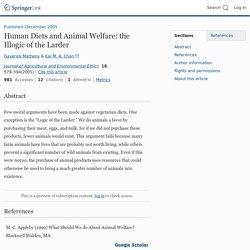

Writing Conclusions: Writing Guides: Writing Tutorial Services: Indiana University Bloomington. Though expectations vary from one discipline to the next, the conclusion of your paper is generally a place to explore the implications of your topic or argument.

In other words, the end of your paper is a place to look outward or ahead in order to explain why you made the points you did. Writing the Conclusion. ProVeg International. Considering that 75% of the world’s adult population is lactose intolerant, it is not surprising that plant milk is the top-selling product in the entire veggie sector.

But it’s not just about lactose intolerance – people choose plant milks over cow’s milk for a variety of reasons, whether it is for their nutritional value, animal welfare, lower environmental impact, to avoid dairy-milk allergens, or simply out of personal preference. One in two American and European consumers uses plant milk, either by itself or in addition to cow’s milk, while in the Asia-Pacific and Latin American regions, it’s more than two-thirds of all consumers. Milk Substitutes: The Best (And Worst) Plant-Based Milk Options. Cow milk consumption is crashing.

Veganism and Living Well. I argue that many philosophical arguments for veganism underestimate what is at stake for humans who give up eating animal products.

By saying all that’s at stake for humans is taste and characterizing taste in simplistic terms, they underestimate the reasonable resistance that arguments for veganism will meet. Taste, they believe, is trivial. Omnivores, particular those that I label “meaningful omnivores,” disagree. They believe that eating meat provides a more meaningful meal, though just how this works proves elusive. This Is How Many Vegans Are In The World Right Now (2020 Update) WordPress database error: [Duplicate entry '8388607' for key 'id']INSERT INTO `wp_et_bloom_stats` (`record_date`, `optin_id`, `record_type`, `page_id`, `list_id`, `ip_address`, `removed_flag`) VALUES ('2020-10-25 17:01:01', 'optin_0', 'imp', 36260, 'mailchimp_b7c874c605', '172.68.65.53', 0) How many vegans are in the world right now, in 2020?

For the last sixty years, veganism has been the minority of another minority; vegetarianism. But, for the last three years, we’ve seen these ‘minorities’ taking over the world. Is the Percentage of Vegetarians and Vegans in the U.S. Increasing? Human Diets and Animal Welfare: the Illogic of the Larder. M.

C. Appleby (1999) What Should We do About Animal Welfare? Blackwell Malden, MA Google Scholar M. C. Appleby J. How Often Do Americans Eat Vegetarian Meals? And How Many Adults in the U.S. Are Vegan? The Vegan Post. Meatonomics: How the Rigged Economics of Meat and Dairy Make You Consume Too ... - David Robinson Simon - Google Books. Comfortably Unaware. In “Comfortably Unaware”, Dr.

Richard Oppenlander tackles the crucial issue of global depletion as it relates to food choice. Do you know the true cost of the food you eat every day? What resources were used and what was destroyed in order to get that food to your plate? What does the word sustainable really mean when applied to your food choices and how sustainable is that particular food to your own health? What you choose to eat is killing our planet, says noted lecturer and author Dr. We should all be committed, he tells us, to understanding the reality and consequences of our diet, the footprint it makes on our environment, and seek food products that are in the best interest of all living things. Dr. Animal Agriculture Research Needs: U.S. Perspective - Critical Role of Animal Science Research in Food Security and Sustainability - NCBI Bookshelf. National Academy of Sciences. Environmental Ethics, Ecological Theology, and Natural Selection: Suffering ... - Lisa Sideris - Google Books.
Meat and Morality: Alternatives to Factory Farming. Adams, C. (1990).

The sexual politics of meat. New York, NY: Continuum. Google Scholar Akers, K. (2008). Ethics. U.S. Beef Production By Year - Beef2Live. Browse Journals By Subject. Environment. Cars or livestock: which contribute more to climate change? * Any views expressed in this opinion piece are those of the author and not of Thomson Reuters Foundation.

What we choose to eat, how we move around and how these activities contribute to climate change is receiving a lot of media attention. In this context, greenhouse gas emissions from livestock and transport are often compared, but in a flawed way. The comparison measures direct emissions from transport against both direct and indirect emissions from livestock.
The Intergovernmental Panel on Climate Change (IPCC) identifies and monitors human activities responsible for climate change and reports direct emissions by sectors. The IPCC estimates that direct emissions from transport (road, air, rail and maritime) account for 6.9 gigatons per year, about 14% of all emissions from human activities. Red Meat and Processed Meat Consumption. Tackling Climate Change Through Livestock. Red and processed meats raise colorectal cancer risk. If your diet is heavy on red and processed meat, it might be time to make some adjustments.

A study of nearly 500,000 people published in the April 17 International Journal of Epidemiology found that people who ate red or processed meat four or more times a week had a 20% higher risk of colorectal cancer than those who indulged less than twice a week. Hoekstra 2012 Water Meat Dairy 1. A Global Assessment of the Water Footprint of Farm Animal Products. Internet Archive: Digital Library of Free & Borrowable Books, Movies, Music & Wayback Machine. Red meat consumption and breast cancer risk. October 9, 2014 — Maryam S Farvid, a visiting scientist and Takemi fellow at Harvard School of Public Health, was first author on two recent studies that found that young women who ate higher amounts of red meat had a higher risk of breast cancer. Q: How strong of a link did you find between eating red meat and increased breast cancer risk? Association Between Vegan Vegetarian and Omnivorous Diets and O.
The origins of Western obesity: a role for animal protein? Meat consumption is associated with obesity and central obesity among US adults. The National Health and Nutrition Examination Survey (NHANES) and study population The NHANES include a series of cross-sectional surveys that provided nationally representative information on the nutrition and health status of the US civilian population. The National Center for Health Statistics (NCHS) conducted three waves of NHANES surveys (NHANES I, II and III) in 1971–1975, 1976–1980 and 1988–1994, respectively. Since 1999, NHANES has been a continuous survey. Health Benefits of a Vegan Diet: Current Insights. Convergence of plant-rich and plant-only diets. We use cookies to enhance your experience on our website. By clicking 'continue' or by continuing to use our website, you are agreeing to our use of cookies.
You can change your cookie settings at any time. We use cookies to enhance your experience on our website.By continuing to use our website, you are agreeing to our use of cookies. You can change your cookie settings at any time.